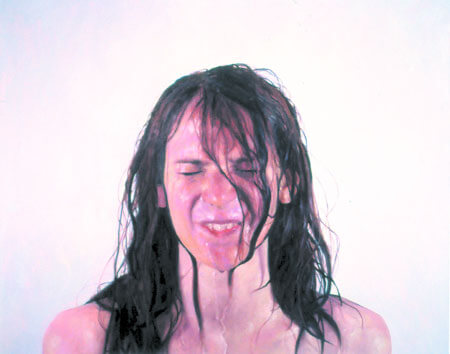Jenny Dubnau’s newest portraits allows viewers to get beneath the skin
Jenny Dubnau’s “Woman Drenched,” 2003. Oil on canvas. 48" x 38".
Courtesy: Black & White Gallery
Jenny Dubnau likes to make her subjects uncomfortable. Her recent series of portraits depict people in awkward face-offs. Dripping wet, bruised mouths smeared with food or shaving cream, close friends are caught off guard and given the painterly once over.
Less self-consciously photo-based than her earlier works, Dubnau’s first exhibition at this Williamsburg gallery consists of eight exquisitely painted heads, all occupying their frames with equal deadpan gravity.
Dubnau photographs her subjects against seamless backgrounds and selects what she deems to be the most revealing image from each session. Curiously, this moment of revelation almost never includes direct eye contact with the artist; the psychological effect of this decision is to give the viewer complete permission to minutely scan an unfamiliar yet fully-realized face, lingering over every scab and eyelash as one would over a lover or cadaver. Veins, imperfections, and textures of mottled skin are lovingly attended to. One can almost sense the blood coursing unevenly beneath the surface.
By isolating her subjects, Dubnau invites us to marvel at her agility as a painter. The light-catching properties of membrane, saliva, and water recall the sensuous attention paid by Dutch still-life painters rather than the clinical sweep of modern day figure painters such as Philip Pearlstein. Much of the pleasure of this exhibition is provided by literally moving around the paintings, shifting from the macro- to microscopic view, and watching the paint morph from representation to rough daubs and back to crisp image.
In “Woman Drenched,” a series of three related paintings, the sitter’s wincing expression and blotchy red skin gives way to a slight, saucy grin emerging from a cascade of hair reminiscent of Veronica Lake. Unlike Susanna Coffey, another painter of discomfiture who revels in the most gnarly aspects of human physiognomy (her own included), Dubnau’s bodies respond subtly to our gaze and their emotions are small, quotidian, even self-effacing. Dubnau’s current paintings demonstrate an increasingly dry wit and an idiosyncratic approach to transforming humble paint into palpable flesh and blood.



































